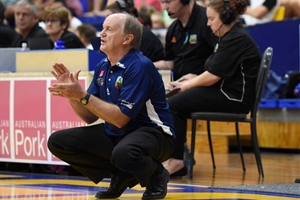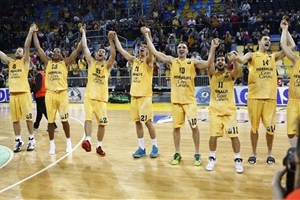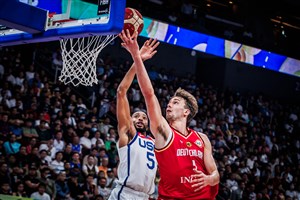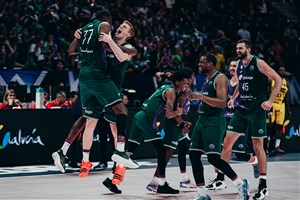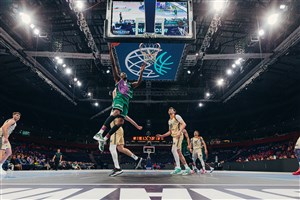
The scoring point guard trend
SAN JUAN (William Rosario's Somewhere in the Americas) - Somebody told me that legendary Argentinean coach and founding father of the country's national league, Leon Najnudel, used to always utter this phrase whenever talking about the necessity of big men in basketball: "It's not my fault Naismith put the baskets at 10 feet from the floor". It's one of those quotes that brings an immediate smile to my face. I find it funny, because it's true.
Be it in international basketball or the NBA… point guards are really good right now. They are the best and most exciting thing to watch in today's game, for sure.
I come to this having been at home for the last couple of weeks, with an opportunity to watch some NBA games with great performances from Stephen Curry, Russell Westbrook, Kyrie Irving, Tony Parker, Chris Paul, Damian Lillard, John Wall and Jeff Teague. The little guys are putting on a show, their show.
Gone are the John Stockton, Jason Kidd and Steve Nash days of setting up the offense and distributing the ball. These point guards, with the exception of Paul, are score first, pass fourth and are not apologetic about it. Six of them will end up in the NBA's top 25 leading scorers this season. The game has gone that way, whether we like it or not.
International basketball in the Americas is also moving in that direction. We are in for one of the all-time great point guard championships in the region this coming August in Monterrey. A quick look at the possible lineups of the participating teams will confirm it. All of them with small frames but big names.
Argentina is a two-headed point guard monster with Facundo Campazzo and Nicolas Lapprovitola, Brazil have Marcelinho Huertas, Canada have Cory Joseph, the Dominican Republic have James Feldeine, Mexico have Jorge Gutierrez, Puerto Rico have Jose Juan Barea, Venezuela have Greivis Vasquez and even Uruguay have up-and-comer Bruno Fitipaldo. It'll be a fun watch, with some crazy numbers being put up by the once playmakers.
But can you win that way? Can a team win the championship with the point guard being their number one option?
In the Americas, to state some examples, the last three continental champs have had the most dominating big men in the event. In 2013, the best player in Caracas throughout the tournament was Gustavo Ayon, averaging 17.5 points along with 9.2 rebounds per game. In 2011, Luis Scola averaged 21.5 points per game, while in 2009 Anderson Varejao and Tiago Splitter combined for 22.3 points and 14.9 rebounds per game. All of them won the championship; Ayon and Scola were MVP, and even though their teams had excellent point guards, the game went through the bigs.
This is why I still hold that the favorites for Monterrey this year are Mexico (if Ayon plays), Canada with Tristan Thompson, Andrew Nicholson, Robert Sacre and Kelly Olynyk, Argentina with Scola and Dominicana (if Al Horford plays). If Brazil have to qualify through Monterrey, with Splitter already confirming his presence in that scenario, you can add them to that list too.
The Americas is still pretty point guard heavy though. That's worrisome, because when it comes time to up the stakes and play in the world stage, against European teams specifically, one big loss or withdrawal from that big men list and it's over. They cannot compete.
This is why Brazil and Mexico looked good at the 2014 FIBA Basketball World Cup. Splitter, Varejao, Nene and Ayon are at that level. And that is why the Dominican Republic couldn't do better… Horford wasn't there.
That is also why Puerto Rico, even with Barea leading the Cup in scoring, had the most disappointing performance out of all the teams from the Americas. Their big men did not even show up to Sevilla. The game went completely through him, shooting 29 more shots than anybody else and ending up tied for third in assists per game on the team.
And then there's defense. While I was writing this column, basketball legend Isaiah Thomas had some comments as a TV analyst in the halftime show of a Golden State Warriors vs. Portland Trailblazers game that seemed bombastic and harsh at first, but quickly became acute observations.
"Perimeter defense does not exist in the NBA right now. They don't even try. There's no hustle or strong defensive stances. This is the worst defensive season I've ever seen," said Thomas.
This thought has been brought up before by coaches and media too when it comes to the international game and the majority of these NBA point guards playing for their national teams. Their defensive effort right now is not great.
So now you are talking about high scoring point guards, with poor ball distribution skills and questionable defense…with so-so big men to anchor their teams. I don’t love this trend.
While I celebrate the fact that we are going to have exciting point guard play in Monterrey this year, I also celebrate those national federations that have not lost focus and fallen in love with it. Argentina and Puerto Rico have pledge the continuity to their tall men recruitment plan ("Plan de altura") for the future. This will allow the game to be played the right way, with the correct basketball philosophy and player structure that has produced winners throughout history.
We need those big men. Najnudel was right. Naismith put those baskets up at ten feet high…that’s just the way it is.
William Rosario
FIBA
FIBA's columnists write on a wide range of topics relating to basketball that are of interest to them. The opinions they express are their own and in no way reflect those of FIBA.
FIBA takes no responsibility and gives no guarantees, warranties or representations, implied or otherwise, for the content or accuracy of the content and opinion expressed in the above article.









